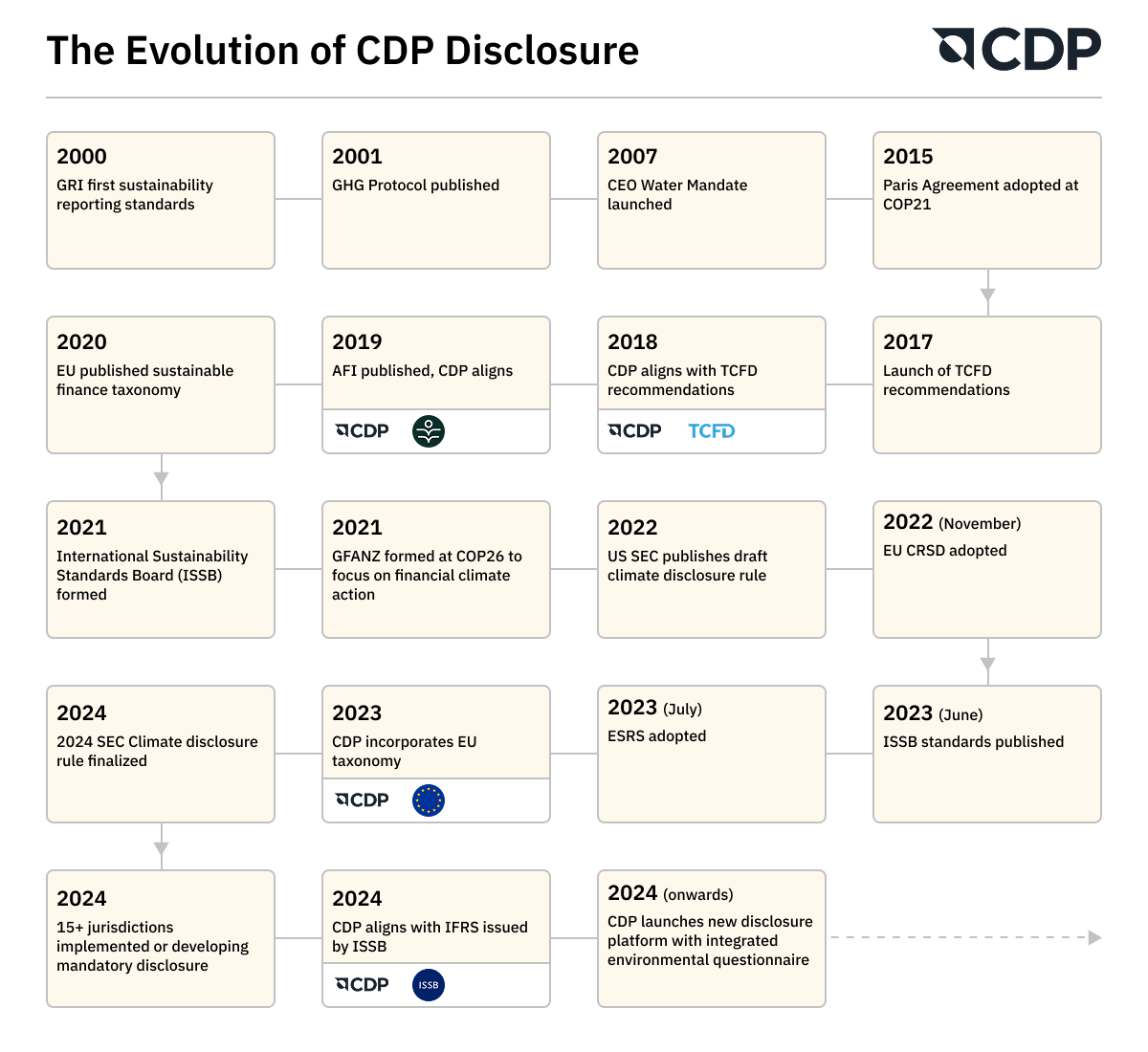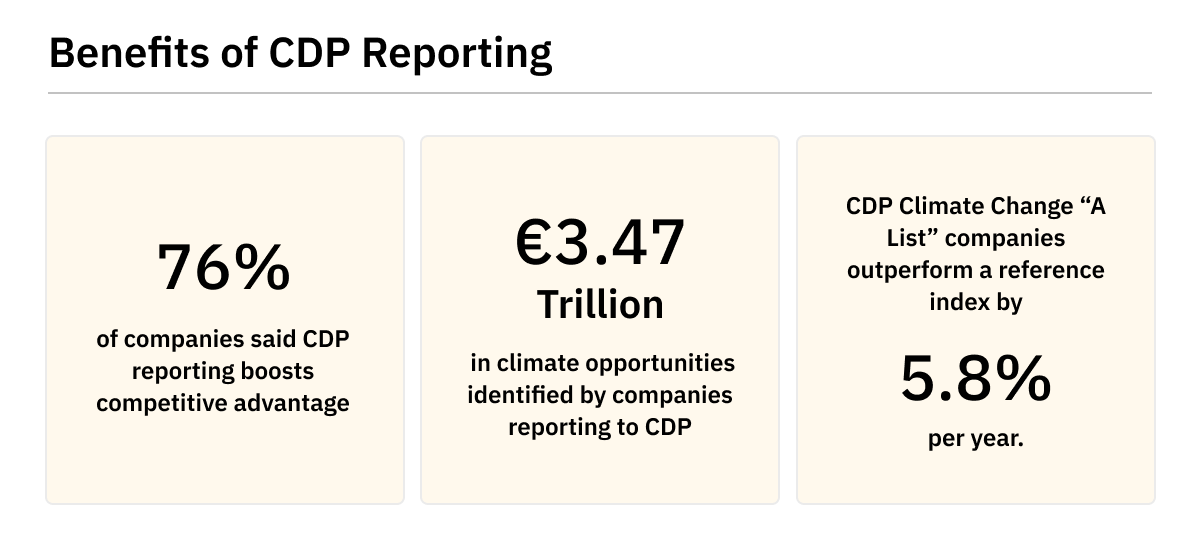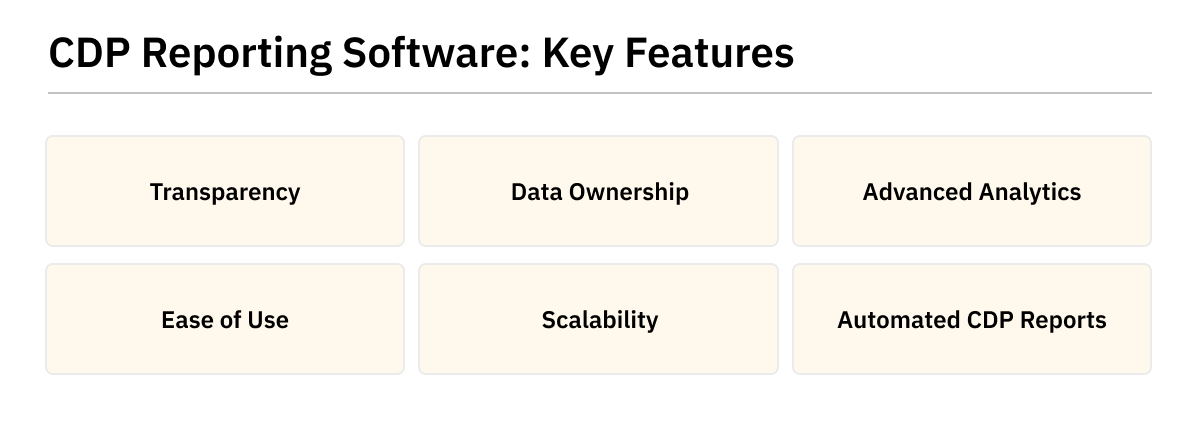CDP, originally known as the Carbon Disclosure Project, runs an international sustainability reporting system that helps investors, companies, and governments manage their sustainability impacts and risks. To achieve a strong score, companies must answer CDP’s questionnaire thoroughly, including providing information on scope 1, 2, and 3 carbon emissions.
A growing number of investors and customers want to understand how different businesses are managing their sustainability impacts and risks, and they’re turning to CDP. The voluntary global reporting system enables stakeholders to ask companies to disclose their impacts in areas like biodiversity, forests, water, and climate change. CDP’s influence is substantial: It now works with more than 700 financial institutions around the world, representing $142T USD in assets. If you’re reporting to CDP, it’s important to understand the process so you can answer as efficiently and transparently as possible.
Below, we provide an overview of CDP reporting — what it is, why it matters, and how you can prepare.
What is CDP Reporting? Why does it matter?
Disclosure through the voluntary platform helps companies meet demand for environmental transparency.
CDP, originally known as the Carbon Disclosure Project, runs an international sustainability reporting system that helps investors, companies, and governments manage their sustainability impacts and risks. In 2024, more than 24,000 companies — including some of the largest in the world — submitted reports to the CDP.
The nonprofit was established in 2000 by Paul Dickinson (a founding member of Persefoni's Sustainability Advisory Board) and Tessa Tennant, who wanted to empower investors to ask companies for environmental transparency.
When an organization receives a request through CDP, it can respond by filling out online questionnaires about climate, deforestation, biodiversity, plastics, and water. CDP reviews the completed questionnaires and assigns a score based on both the company’s impacts and the thoroughness and transparency of its responses. CDP then shares the evaluation with the stakeholder(s) who requested the disclosure, along with the reporting business, which has a chance to identify opportunities to improve its impact.
Organizations don’t have to wait for a CDP request to disclose through the system. They can also submit a voluntary disclosure, which signals a commitment to environmental action and helps companies stay competitive. The number of organizations targeted for CDP climate disclosure has steadily increased since 2021. Meanwhile, regulations like California’s SB 253 and SB 261 are ratcheting up pressure to disclose.
Creating a detailed assessment of your company’s climate impacts and risks can prepare you for investor requests and regulatory compliance. It can also help you reduce your footprint and ensure you’re leading on sustainability rather than falling behind.
For detailed information about the CDP framework and scoring, you can read our CDP Beginner’s Guide.

Why is CDP Reporting Important?
It gives stakeholders decision-useful information and drives sustainability progress.
Over the past two decades, CDP has come to represent the gold standard for environmental reporting. In a report published by the SustAinability Institute by ERM, CDP emerged as the top-rated provider according to both corporate and investor respondents, who regarded it as the most valuable. In terms of quality, it secured the first position among corporate respondents.
Founder Paul Dickinson compares the system to EDGAR, the central database for the US Securities and Exchange Commission. “Assuming you’ve made your disclosure publicly available, it can be seen by the whole financial market,” he explains.
Enterprises like Bloomberg, STOXX, and Goldman Sachs regularly use information distributed through CDP’s platform. The data gives investors valuable insight into which companies are good long-term bets. It also allows them to manage the climate risks within their portfolios and gauge their own carbon footprints. In 2023, the European Investment Bank, Aviva, BlackRock, and New York State Common Retirement Fund were among the hundreds of financial institutions requesting disclosures through CDP.
Over the past two decades, CDP’s influence has become undeniable. The organization works closely with programs like RE100, a corporate renewable energy partnership, and the Science-based Targets Initiative, which aids companies in setting and meeting data-backed emissions goals.
It’s not just investors who rely on the information — it also shapes climate policy and consumer choices. For example, the United Nations Framework Convention on Climate Change (UNFCCC) features CDP data on its Global Climate Action Portal, where it can influence lawmakers to take action.

What Do You Need to Report to CDP?
Emissions data is a cornerstone of disclosure.
CDP asks questions about climate, deforestation, water security, and biodiversity. As part of the climate questionnaire, you’ll be asked to share your scope 1, 2, and 3 emissions. Calculating scope 1 and 2 data is fairly simple, but scope 3 can be much more complex. CDP will ask for your calculation methodology and whether or not your scope 3 data has undergone assurance. For additional information, read our guide, “Integrating Scope 3 Into Your CDP Report.”
CDP Reporting: Emissions Categories
- Scope 1 (Direct Emissions): Fuel consumption (fleet, company-owned or operated assets), process emissions, refrigerants.
- Scope 2 (Indirect Emissions from Energy Use): Electricity, heating, cooling usage, and purchased steam.
- Scope 3 (Value Chain Emissions): Fifteen categories encompassing emissions up and down the value chain, including: purchased goods and services, employee commuting, business travel, waste disposal, transportation and logistics, capital goods, investments, franchises, processing of sold intermediate products, and use and end-of-life treatment of sold products.
Is CDP Reporting Mandatory?
Disclosure is voluntary and beneficial.
While CDP disclosure isn’t mandatory, it can be crucial for meeting stakeholder expectations and protecting your reputation. If investors request environmental data and you fail to respond, you receive an “F” score. This score indicates that you “failed” to provide the requested information and does not necessarily reflect your company’s environmental track record. However, CDP will notify requesting authorities that you’ve declined to participate, and anyone will be able to view your score on the CDP website.
You can choose whether or not to make your questionnaire responses public, but all companies that receive disclosure requests from investors will be listed on the CDP website, and scores are made widely available, whether or not your response is public.
The Benefits of Reporting to CDP
Managing sustainability risks and opportunities.
CDP disclosure enables you to meet stakeholder expectations, uncover hidden risks and opportunities, and improve your sustainability performance.
Disclosure signals to investors, customers, and consumers that you’re prioritizing sustainability. And because CDP’s process exposes emissions hot spots in a company’s operations and supply chain, it makes it easier to problem-solve and follow through on your sustainability commitments. CDP has found that within two years of a successful investor request, disclosing entities reduce their direct emissions by 7-10%.
“True competitiveness means spotting and capitalising opportunities early, and you can’t do that without robust data on sustainable business practices.” - Sherry Madera, CDP Chief Executive Officer
Reporting to CDP makes good business sense because:
- You can’t manage what you don’t measure. The CDP reporting process requires businesses to reconsider how they track performance and manage risks. If you’re in the early stages of your sustainability journey, answering CDP’s questions will help you identify gaps and opportunities so you can create a roadmap for effective emissions reductions.
- Stakeholders are asking for it. The link between sustainability performance and financial performance is not lost on investors. In addition to 700 financial institutions, CDP also works with more than 300 major corporate buyers who are engaging their suppliers through CDP. Disclosure is quickly becoming an expected business norm, demanded by regulators, capital markets, and consumers alike.
- It prepares you for regulatory compliance. Because CDP’s framework aligns with globally recognized frameworks like ISSB, TCFD, and the Greenhouse Gas Protocol (GHGP), voluntary reporting can set you up for more efficient and effective reporting under regulations like California’s Corporate Climate Accountability package and Europe’s Corporate Sustainability Reporting Directive (CSRD).
- It facilitates stakeholder communication. Reporting enables you to share data with investors and customers and manage expectations about your environmental performance.
- It can save money. Disclosure frequently leads to increased efficiency in operations. The steps you take to shrink your carbon inventory — like reducing waste generation and energy use — often deliver significant cost savings as well.
- It helps build business value. CDP’s framework allows you to benchmark yourself against other businesses and identify opportunities for commercial success. In a CDP survey, 76% of organizations said CDP disclosure helps boost their competitive advantage. European companies reporting through CDP have identified an estimated €3.47T EUD in climate opportunities.

The Challenges of Reporting to CDP
Technology solutions can streamline the process.
Businesses responding to CDP disclosure requests — especially for the first time — can face challenges. Despite the growing number of requests from investors, many companies are still not reporting, or are providing only basic information, and therefore earning low scores.
Though the reporting process is far from easy, it’s worth the time and effort. “Climate leadership is a journey,” Dickinson explains. “You want to be on that journey.”
Neglecting to address climate not only leads to reputational risk; it also creates material financial risk. A CDP report showed that a group of the world’s biggest companies valued risks to their businesses from climate change at roughly $1T USD. And environmental transparency correlates with financial success — over the past decade, CDP’s high-scoring “A-List” companies outperformed a reference index by 5.8% per year.
To create a quality CDP disclosure report and establish your company as a climate leader, you’ll likely need to overcome several hurdles:
- Data Complexity. Carbon accounting can demand thousands of data points from a company’s operations and supply chain. Reporting scope 3 emissions is especially challenging because it often relies on cooperation and data sharing with many other organizations.
- Resource Constraints. Gathering and analyzing climate information can tax a company’s budget and staff. Manual carbon calculations eat up employee time — managers often end up passing spreadsheets back and forth, which makes it difficult to ensure accuracy and monitor numbers for quality.
- Capability Gaps. Carbon accounting is still a relatively new field, and many teams aren’t fully prepared to manage data gathering and reporting. Often, they resort to augmenting their teams with costly outsourced support.
- Lack of Support from Internal Stakeholders. The complexity of sustainability reporting can make it tough to cultivate buy-in within an organization. And because reporting requires cooperation from many different teams, this internal support is crucial.
A sound carbon accounting system can address these challenges. Free software like Persefoni Pro allows you to cut through complexity and streamline data collection — including from multiple organizations within a supply chain.
Preparing for CDP Reporting
Start as early as possible.
Gathering and analyzing climate data is time-consuming, and CDP urges disclosing entities to begin the process well before the reporting deadline. It can take 12-18 months to prepare for partial disclosure and two to three years for full disclosure, according to CDP estimates. If the deadline is close and you haven’t started yet, don’t panic. You can follow the steps below to streamline the process.
5 Steps to Prepare for CDP Reporting
- Understand CDP requirements: Familiarize yourself with the specific CDP questionnaire relevant to your sector or the Climate Change, Water Security, or Forests program. Review the scoring methodology and guidance documents provided by CDP.
- Develop an execution plan: Outline key milestones, responsibilities, and deadlines to ensure a smooth and timely completion of the CDP reporting process. A well-structured plan helps manage tasks efficiently and reduces last-minute rush.
- Assemble a cross-functional team for data collection: This team should include representatives from sustainability, finance, operations, supply chain, and any other relevant areas. Collaboration among diverse teams ensures comprehensive data collection and insights from different perspectives.
- Document policies and actions: Clear documentation of the accounting and reporting process provides visibility to all stakeholders and supports your reporting responses.
- Take advantage of technology: Sustainability reporting software greatly simplifies the disclosure process and enhances data accuracy and transparency.
CDP Reporting Deadlines
The window to submit responses to the annual CDP Climate Change questionnaire can vary from year to year, so companies are advised to regularly check CDP's website for the most up-to-date reporting timelines. For 2025, the response window opens the week of June 16, with a scoring deadline of September 15.
CDP 2025 Disclosure Timeline
- Week of March 31 - Questionnaire and guidance published
- Week of April 28 - Scoring methodology published
- Week of June 16 - Response window opens
- Week of September 15 - Scoring deadline
- Week of November 17 - Deadline to submit unscored responses and all amendments

Best Practices for CDP Reporting
If you’re reporting to CDP for the first time or hoping to raise your score, you can follow this set of best practices:
- Don’t leave questions blank. The thoroughness of your responses weighs heavily into your CDP score, so you should answer every question, even in areas where you don’t yet have progress to report.
- Build a culture of sustainability. Solid reporting relies on collaborative data collection and coordination of efforts across departments. It’s important to get internal buy-in early on. You can encourage stakeholder engagement by demonstrating how disclosure advances business interests and primes a company for regulatory compliance.
- Turn risk into opportunity. A robust climate action plan will contribute to a strong CDP report and help you stay nimble in a changing market. You should include a clear strategy for managing climate-related risks and opportunities in the long run. A plan that features board-level oversight, scenario analysis, financial planning, and policy engagement will be more compelling.
- Define clear and measurable targets. Be as specific as possible when responding to CDP — detailed responses demonstrate your commitment to transparency and action. To ensure your organization has measurable and realistic goals, you should set a science-based target using the most current data.
- Implement a centralized data collection system: CDP reporting requires different types of data from a variety of sources, and calculations can be complex. Automated carbon accounting software is the best way to ensure consistency, prepare for auditing, and create a single source of truth within your company. It can also streamline management of scope 3 supplier data, which can be particularly unwieldy.
The Role of Technology in CDP Reporting
Sustainability reporting software saves time and money.
After more than 20 years of working on climate disclosure, Dickinson says one of his biggest concerns is that companies aren’t using the right tools and technology to track their emissions. “We can’t deal with the world’s biggest problem using Excel spreadsheets,” he says. “It’s not the way to run things in the 21st century.”
Automated software has become a must-have for efficient and reliable CDP reporting. There are several key elements you should look for in your sustainability reporting technology.

Features to Look for in CDP Reporting Software
Transparency
Ideally, you’ll be able to easily trace data and see carbon accounting frameworks, formulas, emissions factors, and other components that were used. You should be able to explain how you arrived at a calculation or why numbers have changed from one year to the next.
Ownership of Data
By maintaining control over methodology decisions (like which emissions factor was applied in a calculation), you’ll be better equipped to stand behind the data you report. You should have access to data logs that show when information is added, modified, or deleted and who made the change.
Advanced Analytics & Benchmarking
Your software should support your progress on sustainability. Features to look for include AI-powered insights to detect anomalies and identify decarbonization opportunities, industry benchmarking to compare your performance with peers, and visual dashboards for real-time emissions tracking.
Streamlined User Interface
Teams with no prior carbon accounting experience should quickly be able to enter data and start calculating emissions. It’s helpful if your technology offers guidance on issues like determining which emissions are material and understanding where to find carbon data in your company. You should also have access to a knowledgeable support team to help navigate any roadblocks.
Scalability
It’s likely that your CDP disclosures will grow more sophisticated over time. Your sustainability reporting software should scale with you and be ready to handle increasingly granular and comprehensive data. Read our guide to improving data quality in your CDP report.
Automated CDP Reports
You should be able to generate metrics reports tailored specifically for CDP. For example, Persefoni Sustainability Reporting offers a simple one-click export that populates your answers directly into the CDP questionnaire. To save time, your CDP reporting software should also allow you to create reports for other disclosure frameworks, like California’s SB 253 and SB 261.

Disclose to CDP with Confidence
CDP disclosure provides investors and customers with comparable information about the sustainability impacts and risks of a given company. To achieve a strong score, organizations need to be prepared to answer the CDP questionnaire as thoroughly and transparently as possible. A foundation of credible, traceable carbon data will allow you to disclose to CDP with confidence — and identify opportunities to increase efficiency and build business value.






